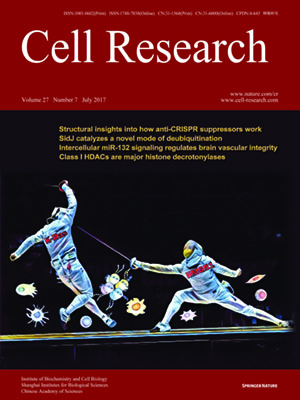
Volume 27, No 7, Jul 2017
ISSN: 1001-0602
EISSN: 1748-7838 2018
impact factor 17.848*
(Clarivate Analytics, 2019)
Volume 27 Issue 7, July 2017: 916-932 | Open Access
ORIGINAL ARTICLES
Intracellular HMGB1 as a novel tumor suppressor of pancreatic cancer
Rui Kang1,4, Yangchun Xie4, Qiuhong Zhang4, Wen Hou4, Qingping Jiang1, Shan Zhu1, Jinbao Liu1, Dexing Zeng2, Haichao Wang3, David L Bartlett4, Timothy R Billiar4, Herbert J Zeh III4, Michael T Lotze4 and Daolin Tang1
1The Third Affiliated Hospital, Center for DAMP Biology, Key Laboratory for Major Obstetric Diseases of Guangdong Province, Key Laboratory of Reproduction and Genetics of Guangdong Higher Education Institutes, Protein Modification and Degradation Laboratory, Guangzhou Medical University, Guangzhou 510510, China
2Department of Medicine, University of Pittsburgh, Pittsburgh, PA 15219, USA
3Laboratory of Emergency Medicine, The Feinstein Institute for Medical Research, Manhasset, NY 11030, USA
4Department of Surgery, Hillman Cancer Center, University of Pittsburgh, Pittsburgh, PA 15219, USA
Correspondence: Daolin Tang, E-mail: tangd2@upmc.edu; Rui Kang,(kangr@upmc.edu)
Pancreatic ductal adenocarcinoma (PDAC) driven by oncogenic K-Ras remains among the most lethal human cancers despite recent advances in modern medicine. The pathogenesis of PDAC is partly attributable to intrinsic chromosome instability and extrinsic inflammation activation. However, the molecular link between these two events in pancreatic tumorigenesis has not yet been fully established. Here, we show that intracellular high mobility group box 1 (HMGB1) remarkably suppresses oncogenic K-Ras-driven pancreatic tumorigenesis by inhibiting chromosome instability-mediated pro-inflammatory nucleosome release. Conditional genetic ablation of either single or both alleles of HMGB1 in the pancreas renders mice extremely sensitive to oncogenic K-Ras-driven initiation of precursor lesions at birth, including pancreatic intraepithelial neoplasms, intraductal papillary mucinous neoplasms, and mucinous cystic neoplasms. Loss of HMGB1 in the pancreas is associated with oxidative DNA damage and chromosomal instability characterized by chromosome rearrangements and telomere abnormalities. These lead to inflammatory nucleosome release and propagate K-Ras-driven pancreatic tumorigenesis. Extracellular nucleosomes promote interleukin 6 (IL-6) secretion by infiltrating macrophages/neutrophils and enhance oncogenic K-Ras signaling activation in pancreatic lesions. Neutralizing antibodies to IL-6 or histone H3 or knockout of the receptor for advanced glycation end products all limit K-Ras signaling activation, prevent cancer development and metastasis/invasion, and prolong animal survival in Pdx1-Cre;K-RasG12D/+;Hmgb1−/− mice. Pharmacological inhibition of HMGB1 loss by glycyrrhizin limits oncogenic K-Ras-driven tumorigenesis in mice under inflammatory conditions. Diminished nuclear and total cellular expression of HMGB1 in PDAC patients correlates with poor overall survival, supporting intracellular HMGB1 as a novel tumor suppressor with prognostic and therapeutic relevance in PDAC.
10.1038/cr.2017.51
FULL TEXT | PDF
Browse 1943


